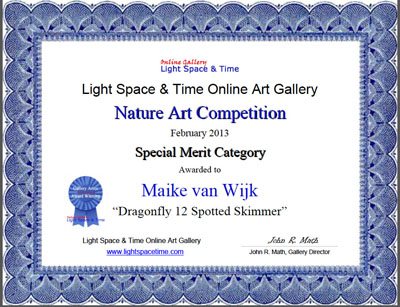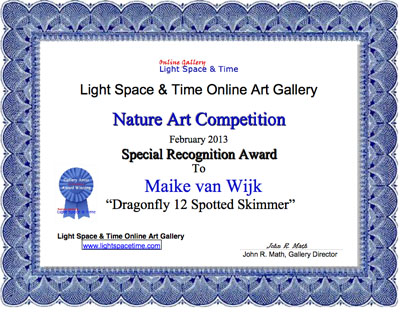Art & Culture, Business
Art Marketing outlined for the newbie
Last month I was part of two online exhibits, which are now entering the archives of their respective sites. Let’s Get Acquainted with Ruby Meadowhawk has been shelved to this link. From the “Nature†Art Exhibition by Light Space & Time, I received a wonderful e-mail by John R. Math informing me about how to market myself.
I learned that my Dragonfly: 12-spotted Skimmer was chosen from 672 worldwide entries. The show organizer helpfully provided me a link to this article “I Was Accepted into an Art Exhibition, Now What?†which offers fabulous tips, some of which are summarized below.
Dragonfly: 12-spotted Skimmer received an Special Recognition Certificate and a Certificate of Merit, which made me very happy (inertia-be-gone!).
I was also informed that I should add collateral materials to my portfolio, including the Event Press Release, Event Postcard and the Event Catalogue (guess I need to spruce up my exhibits page).
It is recommended that artists devote 30 minutes a day to (professional) Social Media Marketing. You should link to the exhibit page (if online) in a Facebook page, and also feature your art on your Facebook page by linking to the online exhibit image. Speaking of Facebook, I’m two likes away from having 100 fans, more than half of  which are ‘strangers’ I haven’t met yet. Technically a few business likes put me over that number, but I haven’t figured out how to track business page likes on Facebook-except through notifications.
Using ‘share buttons’ below the online exhibit art work, where applicable, is also a way to gain visibility. Many web sites now have share buttons for Facebook, Twitter, LinkedIn, Pinterest, and others. Light Space & Time recommends reading Top 10 Reasons Why Artists Fail with Social Media and the Benefits of Using LinkedIn for Professional Artists.
Google + is new to me, so I was glad to read this explanation of their new button: “Whenever you press the +1 button on any post, page, website or Google search page, you are alerting your friends, networks and others that you are ‘endorsing or interested’ in that page or post. People will be curious to see what you recommend and they usually will look too, as they do not want to be left out of something that may be important. …  The more ‘Likes’ and more ‘+1’ that you acquire the more interest, more traffic and more exposure and promotion there will be for your website and your art,†Math wrote.
The use of reciprocal links is also recommended. “Search engines count the number and quality of links to a page and assume that the better and more important websites will contain related links (related to that website’s content) from other related websites,†according to Math.
You can either grab a badge from a blog you admire, or ask the webmaster for a badge if you don’t see it readily available (I don’t have one yet). My sidebar is a blend of artists I admire and reciprocated links. I know some badges on some sites are actually sponsored ads, and I’ve heard of people presuming reciprocation without gently asking the target bloggers and webmasters. To me, my site is a reflection of my life and my brand, and I want to be purposeful in whom or what I link to.
Social bookmarking is listed as another way to alert followers and networks about a post or page. “when employed properly, social bookmarks can create better page ranks and more traffic for the artist’s website,†writes Math. This is a new term and strategy to me, so I will peruse the link that was provided for learning more about social bookmarking: 41 Do-Follow Social Bookmarking Sites That Actually Work.
Press releases are another form of promotion I have not utilized yet. I’ve only thought of them as ways to push my business out to the local media, but the concept of having a Press Release section on my website deserves consideration. I’ll check out the links on: Press Release Marketing for Today’s Artists and How to Write a Press Release for Art Events.
Where to distribute those press releases? Fine Art America, Artspan, Artid and other art communities are recommended by Math. Light Space & Time has further resources here: 20 Free Art Portfolio Websites to Market Your Art.
Then there are suggestions for offline and traditional marketing, including these links: Offline Marketing and Promotion for Successful Artists, 10 Ways an Artist Can Market Their Brand and 10 More Ways an Artist Can Market Their Brand. I find Meetup groups, exhibit openings, and art groups specific to my medium to be excellent ways of learning more about the local art community and building relationships that way.
Math says to stay the course and truly commit to marketing and branding your art, and not get discouraged: Â The Rule of Seven Explains Why Artists Get Discouraged. This list does seem a but daunting at first, but once the logistics have been figured out and times set aside specific to focus, I can implement a lot of these strategies to my business, which will hopefully get my art seen by more than 100 followers.
What are your online and offline marketing tools?
John R. Math has a wealth of other art marketing articles on his blog. I’ve been wowed by the quality of his online exhibit, and look forward to perusing the April Seascapes show. Check the competition link for future calls for art.




